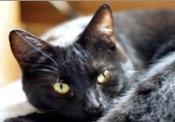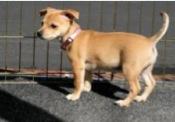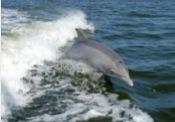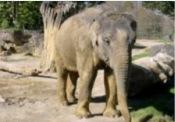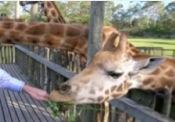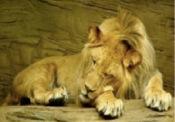Discuss and choose
This activity challenges you to decide on the 'best' number to use in each statement. You may need to do some estimating, some calculating and some research.
Problem
Discuss and Choose printable sheet
This activity challenges you to decide on the 'best' number to use in each of the following statements.
You may like to talk to someone else about what you're thinking. You may need to do some estimating, some calculating and some research.
Please send us your solutions and don't forget to explain how you arrived at your conclusions.

1) There are roughly $10/500/1000$ million domestic cats in the world.
2) On average, cats weigh $1.5/4.5/8$ kg.
3) Domestic cats sleep on average $8-9/13-14/18-19$ hours a day.

4) There are roughly $600/800/1000$ million domestic dogs in the world.
5) The average life of a dog is $10-14/14-18/18-20$ years.

6) Dolphins live in groups called pods or schools of up to $12/20/30$ individuals.

7) Adult elephants need to drink about $100/200/400$ litres of water a day.

8) A giraffe's neck is about $120/170/220$ cm long.
9) A giraffe's tail hair is $2/5/10$ times as thick as the average human hair.

10) On average, male lions weigh $180/250/330$ kg.
11) A lion's roar can be heard $8/12/16$ kms away.
12) On average, lions rest for $10/15/20$ hours a day.
Getting Started
Could you make an estimation?
What extra information might you need to find out?
Student Solutions
Some good suggestions came to us from pupils from many different countries. For some of these questions, the answers might change over time, so if you disagree with any of the solutions below then you might like to do some research to find an up-to-date estimate.
Mya from Ricards Lodge High School, UK sent in the following ideas for number $7$. She showed a good use of animal knowledge and of mathematical skills.
I think that I might have a solution for number $7$.
The question is ... Adult elephants need to drink about $100$/$200$/$400$ litres of water a day. I think that it is ... $100$l.
An average adult human should drink about $2$ litres of water a day (coffee and tea don't count). An average ADULT human weights about between $65$/$80$ kg. So the median of the two numbers is $78$, so it should be approximately $1$l per $39$ kg ($39$ is half $78$), for a human.
So bearing that in mind if an average adult elephant however weighs $4.6$ tons, so converting that into kg that would be $4600$kg. ($1$ ton is equal to $1000$kg.) So that is more than $70$ times more than an average human weight ... because $65$x$70$ would give you $4550$kg - only $50$kg short of $4600$kg.
So if you multiply that by $70$ then multiply the amount of water (litres) by $70$ ... so you would get $140$. Rounding it to the nearest hundred you get $100$l !!
I think that is right.
A group of children at Hardwick Primary School, UK, had some good discussions about this activity. Their teacher wrote to say:
2. On average, cats weigh 1.5/4.5/8kg.
Some children in the class have cats and can lift them up. We used classroom weights and asked one girl to pick them up. She could easily carry 1.5kg, but when we added 3 more kilograms, she said it was hard to hold them all. She said it weighed more than her cat, and she wouldn't be able to lift her cat if it weighed that much. So the children decided that cats must weigh 1.5kg.
3. Domestic cats sleep on average 8-9/13-14/18-19 hours a day.
The children thought that cats sleep 13-14 hours a day because adult humans tend to sleep 8 - 9 hours and children sleep about 12 hours each night. The children who have their own cats noticed that their cats also sleep during the daytime, not just at night, so they think they sleep longer than humans. They didn't think they slept 18-19 hours a day as this would mean they would only be awake for 5 or 6 hours a day.
7. Adult elephants need to drink about 100/200/400 litres of water a day.
The children thought that 400 was the "best" number here. We talked about the fact that children probably drink 1-1.5 litres of water each day, and that adults probably drink about 2 litres. They thought that perhaps the reason elephants were so slow when they moved was because their tummies were so full up of water. They also knew that an elephant must drink a lot of water because they are so large.
We were also sent these ideas by the children at Wold Newton Foundation Primary School:
1. 1000 million (cats) would be equivalent to 1 billion and that is a large number. You have to think of countries that don’t have domestic animals. 10 million would be too small as there is still a large amount of countries that have domestic animals. That is why I think the total number of cats in the world is 500 million.
2. I think that 8kg would be too much as we couldn’t hold 6kg so 8kg is definitely too high. 1.5kg was way too light as it was easy to carry. That is why 4.5kg would be the closest estimate.
4. I think there are 600 million domestic dogs in the world because there are more dogs in the world than cats. 800 million is just too big as not even species like dogs could have that number.
7. 200L would be too much as if they travel in herds of 7 they couldn’t find 1400L every day in the Savannah. 400L is a large amount of water even for an elephant. 100L would be the right estimate as that is potentially how much water each elephant could have.
8. 120cm would be too small as my neck is 6cm so twenty times my neck is not the size of a giraffe’s neck. 170cm would still be too small as it is only an extra 50cm from the size of 120cm. That is why 220cm is the right size for a giraffe’s neck.
11. 8km is about 5 miles and in the savannah there is nothing to stop the sound of the roar from echoing so 8km is too little. 16km is too large of an area as it is equivalent to 10 miles and that is a very large area for a single sound to travel. I think 12km is the right amount of area for a roar to travel.
12. Male lions don’t rest for 10 hours and I rest for about 10 hours so that isn’t it. 20 hours is too large of a time to rest for the average lion as males rest and females hunt. That is why I think 15 hours would be the right estimate for the average lion.
Thank you for sending in your ideas, and well done for thinking carefully about what each of these numbers represents.
Teachers' Resources
Why do this problem?
This activity gives an opportunity to discuss the quantities involved in the statements, and may involve estimation, calculation and/or research. Children will rely not only on what they have learnt from school, but also on information they have picked up from elsewhere. The discussion may well reveal some surprises, particularly in terms of their understanding of different units of measurement.
Possible approach
The activity could be suitable for small group or whole class discussions, depending on the experiences of the children involved. You might find it helpful to print off copies of the printable sheet from the top of the problem page, or you could print a grid of the full set of statements. These can be cut up into separate statements for pupils to focus on one at a time.
Key questions
Possible extension
Children could create their own challenges in a similar way for others to discuss.
Possible support
Try to help by listening, sharing and offering thoughts where appropriate.

